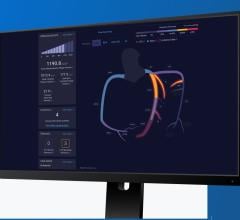
Dictation by radiologist using Nuance's technology. More powerful, intelligent voice operated systems were demonstrated at HIMSS 2019 as a way to help reduce physician burn out when using EHRs.
Here are some takeaway insights on key technologies highlighted at the Healthcare Information Management and Systems Society (HIMSS) 2019 meeting in February. Here we focus on physician burnout, a significant theme at the conference, particularly in relation to electronic health record (EHR) product developments.
Four key technology trends observed at HIMSS included:
• Developments in data sharing and interoperability – particularly in supporting risk stratification and the move toward personalized medicine.
• Business diversification among EHR vendors (both product and vertical market)as their attempt to maintain historic growth rates
• The increasing importance of telehealth at HIMSS, particularly considering recent changes to reimbursement policy within the U.S. Read more on the telehealth trend.
• How EHR vendors will address physician burn-out.
Artificial Intelligence to Support EHR Workflow Innovation
Poor user interface (UI), long-winded data entry procedures, workflow tools that do not speed up processes but slow them down, IT that gets in the way of the clinician-patient relationship instead of supporting it, have all contributed to much of the EHR investment seen across the U.S. over recent years. These issues are also viewed by clinicians with resentment.
Without doubt addressing these issues was a key theme of the show, with most EHR vendors announcing product developments specifically aimed at improving this.
A tour of the Cerner booth at HIMSS19 illustrated several solutions aimed at physician burnout. It announced at the show the launch of “Chart Assist”, an artificial intelligence (AI)-enabled workflow tool that uses neuro-linguistic programming (NLP) to effectively “listen” to a clinician-patient discussion and input data into the EHR in real time. The AI is not limited to supporting the voice input, but also supports adapting the EHR workflow, analyzing and capturing missing data from the EHR and review and validation of the patient diagnosis.
Cerner is a partner of voice recognition and NLP solution provider Nuance, which itself also announced its new AI-powered solution at HIMSS aimed at addressing physician burnout. Its Ambient Clinical Intelligence solution, or ACI, builds on the Dragon Medical One cloud platform used already to support several hundred thousand clinicians with “hands-free clinical documentation.” ACI builds on Dragon by adding assisted workflows, ambient sensing hardware, and task and knowledge automation.
Although launched in 2018, Paul Black, Allscripts’ CEO, continued to push the company’s AI-based EHR product Avenel prior to the show. Unlike Cerner’s and Nuance’s solutions, the focus is less on voice input with Avenel, focusing more on using AI to customize information and provide decision support at the point of care by pre-populating information based on clinical treatment patterns and suggesting areas for efficiency gains for the individual user, organization and location.
M-health and Usability
The use of voice technology and AI for EHR data entry certainly grabs the headlines, but often more subtle developments can be just as important. NextGen Health chose HIMSS to push its mobile EHR platform aimed at supporting physicians in updating EHR using mobile devices, claiming it saved individual physicians more than 12 hours a month compared to those using only its desk-top solution.
NextGen also announced it was collaborating with Availity, one of the U.S.’s largest real-time health information networks, to offer clients NextGen Pre-Service Solutions. The solution supports real-time access to insurance benefit verification, cost estimation, patient financial scripting, address verification and payment options, with NextGen positioning this as a step toward improving efficiency in workflows.
Although eClinicalWorks launched its health information search engine, eCW, in late 2018 and the eClinicalWorks virtual scribe, and Eva, an embedded virtual assistant at HIMSS18, CEO Girish Navini was still emphasizing “the epidemic of physician burnout continuing to threaten the quality of healthcare” during this year’s show. eClinicalWorks was showcasing several solutions on its stand aimed at demonstrating tools that will help providers save time by “eliminating clicks” and “increasingly efficiency and accuracy at the point of care”.
Context aware EHR was also demonstrated by Cerner. Here tags worn by physicians were being used to allow the EHR to respond to the location of the physician in terms of the data that was presented on the screen. For example, as the physician moves around a ward, the EHR would automatically adjust which patient information was being shown depending on the location of the physician, i.e. it would show a patient’s record depending on which bed was being attended.
The Showstopper
Without doubt the use of technology, such as AI, location-based solutions, and NLP are viewed by EHR vendors as an area to differentiate and improve the provider experience and we expect to continue to see an increasing focus on this area in terms of innovation.
However, some of the lower-profile themes will be perhaps more influential short term. These include increased usability testing and design, vendor support for training and best practice, task-based design structures, reduced complexity, common style guides across product portfolios, better research and collaboration with clinicians during the product development phase, etc.
EHR vendors also need to be aware that if they do not address this issue for their customers themselves, others may well step in to do if for them. Vendors such as TransformativeMed offer specialized clinical workflow tools, such as their CORE Value Suite, that sit on top of the EHR and support improving workflows. The company also uses machine learning and offers mobile solutions as part of its portfolio, adding voice input in the near future. During HIMSS it announced University of Tennessee Medical Center as a new customer, adding to a list that includes Baptist Health, Tenet, Catholic Health Initiatives and Dignity Health.
With many factors contribution to physician burn-out, no single solution is going to solve the wider issue. AI driven workflows, NLP enabling better voice interaction with the EHR, mobile EHR and context aware EHR will certainly allow for improvements in what are, in many cases, outdated, often poorly design UI. But, doing the basics well can still provide some quick wins and much needed relief for physicians using these systems.
Read the related blog "6 Key Health Information Technology Trends at HIMSS 2019."
Editor's note: Author Alex Green is company director and principal analyst at U.K.-based Signify Research, which offers market intelligence and consultancy to the global healthcare technology industry. He has 21 years’ experience in tech market intelligence and leads Signify's digital health offerings focusing on population health management, EHR/EMR and telehealth. Prior to joining Signify he served as a Senior Research Director at IHS and as a Business Analyst/IT Project Manager in a joint NHS/Government role. For more information, www.signifyresearch.net.


 April 16, 2025
April 16, 2025 








